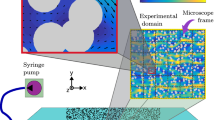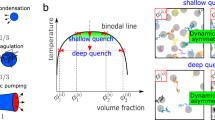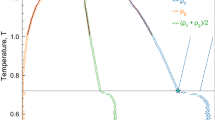Abstract
WHEN immiscible liquids with different viscosities are forced to flow through a channel, the more viscous liquid tends to concentrate in the centre. This process influences the flow of oil–water mixtures in pipelines1,2, the extrusion of polymers3, the flow of blood in small arteries4 and of magmas approaching the Earth's surface during a volcanic eruption5. Segregation occurs because it minimizes the pressure required to maintain a given flow rate6,7; there is still scant information, however, on the timescales and fluid configurations involved in the approach to the equilibrium state. Explicit solutions of the time-dependent Navier–Stokes equation using numerical (for example, finite-element3) methods are possible only for simple interface shapes. Here we use an alternative approach to the study of viscous segregation, involving immiscible lattice-gas automata. Two-dimensional calculations exhibit the expected segregation for a variety of starting configurations, and for an initially homogeneous emulsion the fluid must flow 50–100 times the channel width before most of the more viscous fluid reaches the channel centre. For constant flow rates, segregation occurs so as to progressively decrease the pressure.
This is a preview of subscription content, access via your institution
Access options
Subscribe to this journal
Receive 51 print issues and online access
$199.00 per year
only $3.90 per issue
Buy this article
- Purchase on Springer Link
- Instant access to full article PDF
Prices may be subject to local taxes which are calculated during checkout
Similar content being viewed by others
References
Joseph, D. D., Nguyen, K. & Beavers, G. S. J. Fluid Mech. 141, 319–345 (1984).
Charles, M. E. & Lilleleht, L. U. Can. J. chem. Engng 43, 110–116 (1965).
Karagiannis, A., Mavridis, H., Hrymak, A. N. & Vlachopoulos, J. Polymer Engng Sci. 28, 982–988 (1988).
Quemada, D. in Arteries and Arterial Blood Flow (ed. Rodkiewicz, C. M.) 91–105 (Springer-Verlag, New York, 1983).
Carrigan, C. R. & Eichelberger, J. C. Nature 343, 248–251 (1990).
Joseph, D. D., Renardy, M. & Renardy, Y. J. Fluid Mech. 141, 309–317 (1984).
Than, P. T., Rosso, F. & Joseph, D. D. Int. J. Engng Sci. 25, 189–204 (1987).
Frisch, U., Hasslacher, B. & Pomeau, Y. Phys. Rev. Lett. 56, 1505–1508 (1986).
Frisch, U. et al. Complex Systems 1, 648–707 (1987).
Rothman, D. H. & Keller, J. M. J. stat. Phys. 52, 1119–1127 (1988).
Preziosi, L., Chen, K. & Joseph, D. D. J. Fluid Mech. 201, 323–356 (1989).
Lim, H. A. Phys. Rev. A40, 968–980 (1989).
Hayot, F. Complex Systems 1, 753–761 (1987).
Oliemans, R. V. A. & Ooms, G. in Multiphase Science and Technology Vol. 2 (eds Hewitt, G. F., Delhaye, J. M. & Zuber, N.) 427–472 (Hemisphere, Washington, DC, 1986).
d'Humières, D., Lallemand, P. & Searby, G. Complex Systems 1, 633–647 (1987).
Schechter, R. S. The Variational Method in Engineering, 135–148 (McGraw-Hill, New York, 1967).
Dahlburg, J. P., Montgomery, D. & Doolen, G. D. Phys. Rev. A36, 2471–2474 (1987).
Gunstensen, A. K. & Rothman, D. H. Physica D (in the press).
Chen, S., Chen, H. & Doolen, G. D. Complex Systems 3, 243–251 (1989).
Somers, J. A. & Rem, P. C. Cellular Automata and Modeling of Complex Physical Systems (eds Manneville, P., Boccara, N., Vichniac, G. Y. & Bidaux, R.) 161–177 (Springer, Berlin, 1990).
Author information
Authors and Affiliations
Rights and permissions
About this article
Cite this article
Stockman, H., Stockmant, C. & Carrigan, C. Modelling viscous segregation in immiscible fluids using lattice-gas automata. Nature 348, 523–525 (1990). https://doi.org/10.1038/348523a0
Received:
Accepted:
Issue Date:
DOI: https://doi.org/10.1038/348523a0
Comments
By submitting a comment you agree to abide by our Terms and Community Guidelines. If you find something abusive or that does not comply with our terms or guidelines please flag it as inappropriate.



